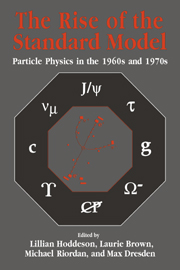Book contents
- Frontmatter
- Contents
- Contributors
- Editors' Acknowledgments
- Photographs of the Symposium
- Abbreviations and Acronyms
- Mathematical Notation
- Part One Introduction
- Part Two Quarks and Leptons
- Part Three Toward Gauge Theories
- Part Four Accelerators, Detectors, and Laboratories
- Part Five Electroweak Unification
- Part Six The Discovery of Quarks and Gluons
- 29 Early Baryon and Meson Spectroscopy Culminating in the Discovery of the Omega-Minus and Charmed Baryons
- 30 Quark Models and Quark Phenomenology
- 31 From the Nonrelativistic Quark Model to QCD and Back
- 32 Deep-Inelastic Scattering and the Discovery of Quarks
- 33 Deep-Inelastic Scattering: From Current Algebra to Partons
- 34 Hadron Jets and the Discovery of the Gluon
- Part Seven Personal Overviews
- Index
32 - Deep-Inelastic Scattering and the Discovery of Quarks
Published online by Cambridge University Press: 03 February 2010
- Frontmatter
- Contents
- Contributors
- Editors' Acknowledgments
- Photographs of the Symposium
- Abbreviations and Acronyms
- Mathematical Notation
- Part One Introduction
- Part Two Quarks and Leptons
- Part Three Toward Gauge Theories
- Part Four Accelerators, Detectors, and Laboratories
- Part Five Electroweak Unification
- Part Six The Discovery of Quarks and Gluons
- 29 Early Baryon and Meson Spectroscopy Culminating in the Discovery of the Omega-Minus and Charmed Baryons
- 30 Quark Models and Quark Phenomenology
- 31 From the Nonrelativistic Quark Model to QCD and Back
- 32 Deep-Inelastic Scattering and the Discovery of Quarks
- 33 Deep-Inelastic Scattering: From Current Algebra to Partons
- 34 Hadron Jets and the Discovery of the Gluon
- Part Seven Personal Overviews
- Index
Summary
In 1961 Murray Gell-Mann and Yuval Ne'eman independently introduced a classification scheme, based on SU(3) symmetry, that placed hadrons into families on the basis of spin and parity. Like the periodic table for the elements, this scheme had predictive as well as descriptive powers. Hadrons that were predicted within this framework, such as the Ω−, were later discovered.
In 1964 Gell-Mann and George Zweig independently proposed quarks as the building blocks of hadrons as a way of generating the SU(3) classification scheme. When the quark model was first proposed, it postulated three types of quarks - up (u), down (d), and strange (s), having charges ⅔, – ⅓, and – ⅓, respectively; each of these was hypothesized to be a spin-½ particle. In this model the nucleon (and all other baryons) is made up of three quarks, and all mesons each consist of a quark and an antiquark. For example, as the proton and neutron both have zero strangeness, they are (u,u,d) and (d,d,u) systems, respectively. Though the quark model provided the best available tool for understanding the properties of the hadrons that had been discovered at the time, the model was thought by many to be merely a mathematical representation of some deeper dynamics, but one of heuristic value.
- Type
- Chapter
- Information
- The Rise of the Standard ModelA History of Particle Physics from 1964 to 1979, pp. 566 - 588Publisher: Cambridge University PressPrint publication year: 1997
- 2
- Cited by



